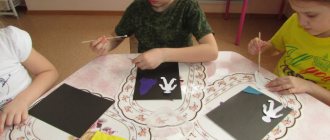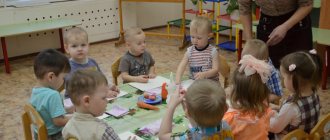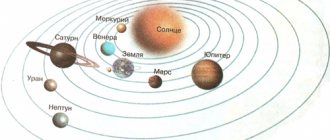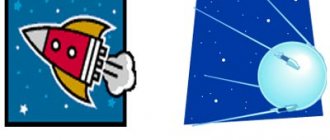Space exploration is possible with children of preschool and early school age. Kids are interested in everything. But since it is still difficult to scientifically tell them the entire theory of the starry sky, pictures, drawings, cartoons, games, coloring books, stories, poems, songs and even riddles about space for children will come to the aid of parents and educators. You can find all this on the website.
Here you can watch a free video presentation for children using the Doman method about Space and the Planets of the Solar System - planets of the solar system for children.
Games for children of preschool and primary school age are aimed at developing fine motor skills of the fingers, memory, logic, attentiveness, creative games, coloring and much more. In addition, here you can download cards with the Planets for children for free - real photographs and drawings.
With the help of such fun and simple games, you will instill in your child a love of Space, he will discover a lot of new and unknown things for himself, and get acquainted with the world around him.
Games
Here you can download cards with Planets for children for free. Click on the picture to print.
How to play?
For the youngest kids, you can simply show cards with the Planets and list their names. Then invite the child to choose first from two options, then the more necessary Planet. A very good game is when you print out two options with these space cards, cut one option into cards with Planets and invite the child to lay out the cards with Planets and name the name of this or that Planet. You can also play a very good game to develop memory - print out two versions with the Planets of the Solar System, cut them into cards, turn them over and find two identical Planets in pairs.
Another free space game. Print, cut into cards and make up a story with your child about the Planets of the Solar System, about astronauts, etc. This game is aimed at developing speech, fine motor skills of the fingers and getting to know the world around us.
A space game to develop mindfulness.
Here you need to find the extra ones in each line.
We develop logic in a child. Here we need to continue the logical series.
on the development of fine motor skills of children's fingers. Here you need to help the rockets get to the Planets - circle the dotted line with a pencil.
Space puzzle for kids. Cut the pictures into as many pieces as your child can put together.
A game to develop attention. Here you need to connect identical Planets.
We train cutting skills. Here you need to cut the sheet along the dotted line.
Space sorting game. Here you need to sort into Planets and Flying Ships.
We sort the Planets by size: large, medium and small.
Here you need to color Planet Earth by numbers. Creative game for children.
Educational activity “Space” for children from 3 to 4 years old.
- Seal
Details Author: Nalivaykina Lyudmila Published August 26, 2016
Stars, planets, solar system, space... Some parents introduce children to these concepts almost from the age of six months.
I have always believed that a child should be introduced only to the information that he can perceive and present due to his age. We tried to teach a lesson on the topic “Space” at the age of 3, and it turned out to be very successful - Dasha played new games with interest, and then she herself “taught” the knowledge she had acquired to me, passionately explaining how hot the Sun turns out to be, and how It's cold for the astronaut in space, and dad listened to an impressive story about what would happen to his car if a planet fell on it.
So, our lesson:
We conducted the developmental lesson “Space” in two stages - over two days. On each of these days, we watched a presentation (so that the material was thoroughly absorbed) and did astronaut exercises (because it is useful and relieves stress).
Video materials
Children love to check information and see its accuracy with their own eyes. A cartoon about astronauts and planet Earth will help you with this. Video clips will clearly show children how our solar system lives.
Why? “What kind of planets are there?”
This cartoon, whose heroes are a boy, a girl and a cosmic creature, will tell you what the planets of the solar system are like. Here the children will clearly see how it is built, what is the diameter of the Earth, what are the distances between the planets. The study of astronomy is structured in a fascinating way, in the form of a journey of heroes. You can watch the cartoon here
Astronomy for the little ones
The cartoon is dedicated to the study of the movement of planets in orbits. Children will see with their own eyes how space works. They will be invited on a journey by the astronaut bunny, the main character of the video. If you use your imagination, you can fly on spaceships and learn a lot from aliens. You can watch the cartoon here
Film series Dizyak Mizyak
Dizyak Mizyak's studio offers children a film about space, in which letters and syllables are simultaneously studied. An astronaut and a spaceship bring letters to an unknown planet. Thanks to such a clear and visual way, children quickly learn to read. You can download or watch the video here
Presentation “Space and Man”
This presentation is based on scientific facts, real photographs and space footage. It talks about astronauts and the structure of space and is perfect for schoolchildren. You can download or watch it here
Also on the site you will find songs and poems about space. Have fun studying!
Charging an astronaut
Flexible breaks between tasks are very important! Some children will not be able to conduct a lesson at all without them (we are just part of this group of “some” fidgets).
I told Dasha that we really need to fly into space, but only very strong people are accepted there and the astronauts train a lot before the flight. Therefore, we need to do good exercises.
The charging tasks were as follows (the pictures are not the most “designer” - I apologize, this is not my profile):
Exercise 1. Running around the room - for warming up.
Exercise 2. Walking on your toes, on your heels, walking along a massage path (any other massage surface - cereals, pebbles, pencils, etc.).
Fitball exercises.
(If you slightly change the exercises, you can use a simple ball of medium diameter. Attention! When performing all the exercises, hold the child tightly. You can secure the baby well if you take his two legs in your hands and press them tightly to the ball, and hold the ball itself with your feet. )
Exercise 3. We train the vestibular apparatus (everything like real astronauts). We sit the child on the ball, holding his legs tightly, and begin to bounce up and down on the ball (it turns out that the baby seems to be jumping on the ball). Then we place the child on his back on the ball and rotate the ball clockwise and counterclockwise.
We strengthen the abs and lower back muscles.
Exercise 4 . The child sits on the ball, the mother secures it well, taking both legs and pressing them to the ball (so as not to drop it! This is very important!). We begin to rock the child back and forth. We try to make the maximum possible amplitude.
Exercise 5. Swing the child on the ball left and right:
Exercise 6. Still fixing the child well, we rotate him and the ball in a plane parallel to the floor, clockwise and counterclockwise (as the green arrow in the photo suggests):
When performing these three exercises, the child will involuntarily deviate back and forth, while the abdominal and back muscles are well worked out.
Strengthening your arms and back.
Exercise 7. We ask the child to pick up toys from the floor (the toys are positioned so that he has to reach them in his arms):
Exercise 8. We ask the child to raise his hands up - we fly up like a rocket. If the child does not comply with the request, you can ask him to take the toy that we hold above his head.
Exercise 9. Walking on your hands around the room is an excellent exercise for your arms, back, and abs:
Exercise 10. Stepping over obstacles (strengthening the legs) - lay out tall objects on the floor (stuffed toys, pillows, stacks of books, anything taller than 30 cm). We ask the child to step over them (while raising his legs high).
We launch a rocket into space.
I included this game as a “recess” so that the child could rest and play before the next task.
We took our constructed lego rocket and played launch. “Five-four-three-two-one-GO!” Our rocket flew through the airless space of the room and every now and then landed on different “planets”. At the end, the rocket returned home, the astronauts were greeted with applause and shouts of “Pos-drav-la-yu!” (everything is like in life). Dasha liked the moment of meeting the cosmonauts the most - she had to meet them three times.
A musical moment.
This minute was introduced to relax between tasks. I suggested that Dasha listen to “cosmic music”. We lay down on the pillows and turned on the music (this one). While listening to music, you can fantasize about what it wants to tell us about (the child will listen with interest as the music talks about how the ship is flying between the stars and planets, how there is darkness and cold for hundreds of kilometers around, and how it flies - swift , fast, beautiful to a distant planet, etc.). Playing “what the music says” is a very good way to develop an ear for music and the ability to truly appreciate and listen to music.
Who's the odd one out?
It was necessary to find an extra card in a row.
A file with cards is possible.
Dasha could not find all the extra cards on her own; she needed a hint. For example, for these cards:
there was this hint: “Rockets are about to fly into space. Everyone was flying high, high! Up to the stars! But one did everything wrong! What kind of rocket was it?
In principle, such hints can be given to any row of cards if the child finds it difficult to choose the extra one. It’s just that it can be difficult for children to complete not the task itself, but to understand the logic of the question - how is it “extra”. Simple hints can help with this, and over time the child will get used to the concept of “extra” and learn to look for an extra card without hints.
For the fact that the child guessed every extra card, he is entitled to a PRIZE - the guessed card is given to him as a prize forever (children love small bright pictures, and usually the prospect of winning such a prize is very motivating to complete the task).









